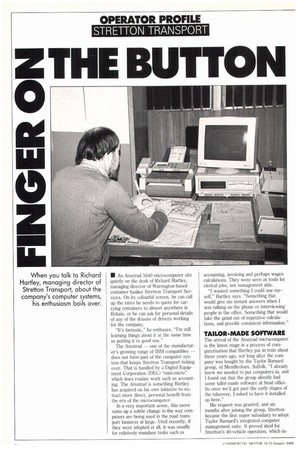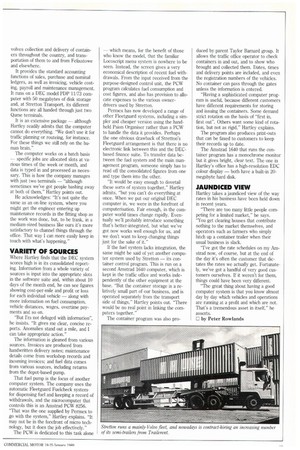Z THE BUTTON
Page 38

Page 39

If you've noticed an error in this article please click here to report it so we can fix it.
• An Amstrad 1640 microcomputer sits quietly on the desk of Richard Hartley, managing director of Warrington-based container haulier Stretton Transport Services. On its colourful screen, he can call up the rates he needs to quote for carrying containers to almost anywhere in Britain, or he can ask for personal details of any of the dozens of drivers working for the company.
"It's fantastic," he enthuses. "I'm still learning things about it at the same time as putting it to good use."
The Amstrad — one of the manufacturer's growing range of IBM compatibles — does not form part of the computer system that keeps Stretton Transport ticking over. That is handled by a Digital Equipment Corporation (DEC) "mini-micro" which does routine work such as accounting. The Amstrad is something Hartley has acquired on his own initiative to extract more direct, personal benefit from the era of the microcomputer.
In a very important sense, this move sums up a subtle change in the way computers are being used in the road transport business at large. Until recently, if they were adopted at all, it was usually for relatively mundane tasks such as accounting, invoicing and perhaps wages calculations. They were seen as tools for clerical jobs, not management aids.
"I wanted something I could use myself," Hartley says. "Something that would give me instant answers when I was talking on the phone or interviewing people in the office. Something that would take the grind out of repetitive calculations, and provide consistent information."
TAILOR-MADE SOFTWARE
The arrival of the Amstrad microcomputer is the latest stage in a process of computerisation that Hartley put in train about three years ago, not long after the company was bought by the Taylor Barnard group, of Mendlesham, Suffolk. "I already knew we needed to put computers in, and I found out that the group already had some tailor-made software at head office. So once we'd got past the early stages of the takeover, I asked to have it installed up here."
His request was granted, and six months after joining the group, Stretton became the first major subsidiary to adopt Taylor Barnard's integrated computer management suite. It proved ideal for Stretton's 40-vehicle operation, which in volves collection and delivery of containers throughout the country, and transportation of them to and from Felixstowe and elsewhere.
It provides the standard accounting functions of sales, purchase and nominal ledgers, as well as invoicing, vehicle costing, payroll and maintenance management. It runs on a DEC model PDP 11/73 computer with 50 megabytes of disk storage and, at Stretton Transport, its different functions are all handed through just two Qume terminals.
It is an extensive package — although Hartley readily admits that the computer cannot do everything. "We don't use it for traffic planning or routeing, for instance. For these things we still rely on the human brain."
The computer works on a batch basis — specific jobs are allocated slots at various times of the week or month, and data is typed in and processed as necessary. This is how the company manages with just two terminals — "although sometimes we've got people bashing away at both of them," Hartley points out.
He acknowledges: "It's not quite the same as an on-line system, where you might get the engineer entering up maintenance records in the fitting shop as the work was done, but, to be frank, in a medium-sized business like ours it's more satisfactory to channel things through the office. That way I can more easily keep in touch with what's happening."
VARIETY OF SOURCES
Where Hartley finds that the DEC system scores high is in its consolidated reporting. Information from a whole variety of sources is input into the appropriate slots in the software suite and, within about 10 days of the month end, he can see figures showing cost-per-mile and profit or loss for each individual vehicle — along with more information on fuel consumption, vehicle distances, wages, overtime payments and so on.
"But I'm not deluged with information", he insists. "It gives me clear, concise reports. Anomalies stand out a mile, and I can take appropriate action."
The information is gleaned from various sources. Invoices are produced from handwritten delivery notes; maintenance details come from workshop records and incoming invoices; and fuel data comes from various sources, including returns from the depot-based pump.
That fuel pump is the focus of another computer system. The company uses the automatic Fleetguard Fuelcheck system' for dispensing fuel and keeping a record of withdrawals, and the microcomputer that controls this is an Amstrad PCW 8256. "That was the one supplied by Permex to go with the system," Hartley explains. "It may not be in the forefront of micro technology, but it does the job effectively."
The PCW is dedicated to this task alone — which means, for the benefit of those who know the model, that the familiar Locoscript menu system is nowhere to be seen. Instead, the screen gives a very economical description of recent fuel withdrawals. From the input received from the purpose-designed control unit, the PCW program calculates fuel consumption and cost figures, and also has provision to allocate expenses to the various ownerdrivers used by Stretton.
Permex has now developed a range of other Fleetguard systems, including a simpler and cheaper version using the handheld Psion Organiser rather than a PCW to handle the data it provides. Perhaps the one obvious drawback of Stretton's Fleetguard arrangement is that there is no electronic link between this and the DECbased finance suite. To transfer data between the fuel system and the main management program, someone simply has to read off the consolidated figures from one and type them into the other.
"It would be easy enough to dovetail these sorts of system together," Hartley admits, "but you can't do everything at once. When we put our original DEC computer in, we were in the forefront of computerisation. Fair enough, in the computer world times change rapidly. Eventually we'll probably introduce something that's better-integrated, but what we've got now works well enough for us, and we don't want to keep changing things just for the sake of it."
If the fuel system lacks integration, the same might be said of yet another computer system used by Stretton — its container control program. This is run on a second Amstrad 1640 computer, which is kept in the traffic office and works independently of the other equipment at the base. "But the container storage is a relatively small part of our business, and is operated separately from the transport side of things," Hartley points out. "There would be no real point in linking the computers together."
The container program was also pro duced by parent Taylor Barnard group. It allows the traffic office operator to check containers in and out, and to show who brought and collected them. Dates, times and delivery points are included, and even the registration numbers of the vehicles. No container can pass through the gates unless the information is entered.
"Having a sophisticated computer program is useful, because different customers have different requirements for storing and issuing the containers. Some demand strict rotation on the basis of "first in, first out". Others want some kind of rotation, but not as rigid," Hartley explains.
The program also produces print-outs that can be faxed to customers to keep their records up to date.
The Amstrad 1640 that runs the container program has a monochrome monitor but it gives bright, clear text. The one in Hartley's office has a high-resolution EDC colour display — both have a built-in 20megabyte hard disk.
JAUNDICED VIEW
Hartley takes a jaundiced view of the way rates in his business have been held down in recent years.
"There are too many little people competing for a limited market," he says. "You get clearing houses that contribute nothing to the market themselves, and operators such as farmers who simply hitch up a container trailer when their usual business is slack.
"I've got the rate schedules on my Amstrad now, of course, but at the end of the day it's often the customer that dictates the rates we actually get. Fortunately, we've got a handful of very good customers ourselves. If it weren't for them, things could have been very different.
"The great thing about having a good computer system is that you know almost day by day which vehicles and operations are running at a profit and which are not. That's a tremendous asset in itself," he asserts.
0 by Peter Rowlands
































































































